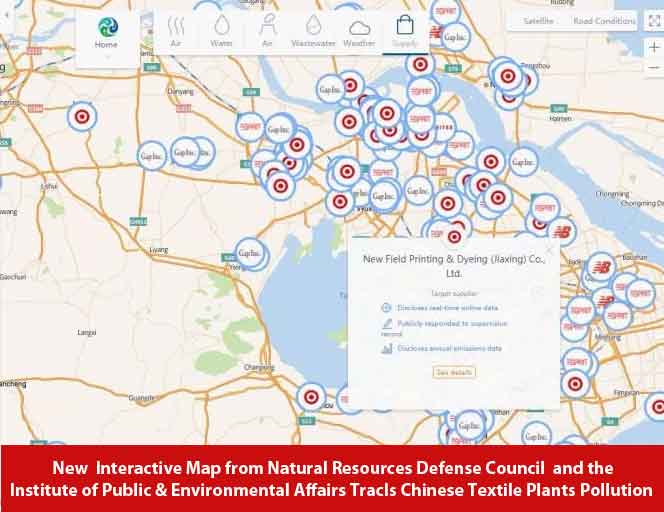For many years, environmental groups have been pointing their fingers towards many of the Chinese textile manufacturers that supply materials to Western retailers and apparel brand companies, saying these were often huge sources of pollution.
The most prominent accusations involve reports of the textile companies dumping toxic chemicals used for dyeing and finishing fabrics directly into local waterways untreated, often turning them into strange unnatural colors. Those and other actions are also said to cause health problems for nearby residents and wildlife.
Even the apparel and retail companies themselves are often unaware of what is happening with these textile suppliers, and consumers are almost totally in the dark.
Now, new joint project by the US Natural Resources Defense Council (NRDC) and in the Institute of Public & Environmental Affairs (IPE) - a leading environmental NGO in China - has developed a tool that makes it easier for companies and eventually even shoppers to keep track textile suppler pollution.
The tool involves use of an interactive on-line map (see graphic below) showing the official supplier factories for brands that have signed onto the effort, and the pollution each is producing.
Brands like Inditex/Zara, Gap, Target, Puma, New Balance and Esprit are already participating in the project, and their supplier and environmental data is featured in the map.
It work like this: Visitors to the site can select a brand or retailer of interest, and the map will populate with the company's known suppliers. Users can then click in to a supplier to reveal the facility name and address and reports on any violation records, and find out how the supplier is performing in terms of emissions, water use and wastewater discharge, almost at that very moment. Users and can also review a 30-day trend of emissions and discharges at each facility.
The project is still in early stages, but the goal is to make it so anyone can quickly see which factories are frequent violators, and which brands they're supplying. Of course, the brands could use the information to move more of their business to the good performers, and to pressure underperforming factories to clean up, or risk losing them as customers.

"Until now, customers have lacked effective tools to assess the environmental impact of their favorite brands' global operations," said Linda Greer, senior health scientist for NRDC and founder of its Clean by Design green supply chain program. "These companies that have stepped up to put their names first on the inaugural map are showing new levels of transparency on their manufacturing abroad and are demonstrating real leadership in supply chain responsibility."
Greer added that "To me, the low-hanging-fruit opportunity for brands to reduce their carbon impact and their water impact and these other impacts is for them to begin to benchmark their suppliers, in ways that this map and this data allow them to begin to do, and then to reward market share to good performers."
How does the map tool acquire the data? It comes from a project initiated by China's government, which has been working at last to address the serious pollution problems in the country, using probes to monitor the pollution of thousands of Chinese factories. They are places wherever the factory's wastewater discharges, and send readings automatically to the IPE system.
The Chinese government gets that report every two hours, so that's how often NRDC's and IPE's map gets updates.
Currently, the map shows a lot of technical data, and can be a little slow to load. The partners plan to add features that make the data usable for non-experts before long.
The IPE also says it plans to start similar tracking for suppliers in other industries such as electronics in the future.
Do you think this tool will be useful? Let us know your thoughts at the Feedback button below.

|